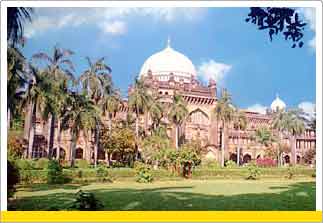| Home >> Tourist Cities in India >> Tour to Mumbai India >> History of Mumbai | |||
| History of Mumbai | |||
|
History of Mumbai | Tourist attractions in Mumbai | Tours from Mumbai 
India tours and travel takes you to Mumbai, the commercial capital of India, which originally consisted of seven islands called Colaba, Mazagaon, Old Woman's Island, Wadala, Mahim, Parel, and Matunga-Sion.It was these islands which were later joined together for the formation of the city. A tour to Mumbai would let you have an insight into the history of Mumbai, which is ancient yet modern. The city of Mumbai soon developed as a trading port because of its fine harbor and the number of merchants who were attracted from other parts of India. Migrants to Mumbai included sizeable communities of Parsis and Gujaratis, and south Indian Hindus fleeing Portuguese persecution in Goa. Their arrival, and that of later immigrant groups, laid the basis for city's celebrated multicultural society. Within 20 years, the presidency of the East India Company was transferred to Mumbai from Surat, and the town soon became the trading headquarters for the whole west coast of India. History of Mumbai states the fact that in 1662 the islands of Mumbai were given to English King Charles II, later on in 1668 the English East India Company acquired the islands for an annual sum of 10 pounds in gold. It was in 1853 that, a 21-mile long railway line, the first in India, between Bombay's Victoria Terminus and Thana was opened. The Great Indian Peninsular and the Bombay Baroda and Central India Railway were started in 1860 and a regular service of steamers on the west coast was commenced in 1869. In 1858, following the First War of Independence of 1857, the East India Company was accused of mismanagement and the islands. Travel to Mumbai would take you to the popular buildings of Mumbai, which were said to be established in the later half of the 19th century. The most popular amongst them is the Gateway of India, which was built to commemorate the visit of king George V and Queen Mary for the Darbar at Delhi in 1911. Other main buildings like the Victoria Terminus, the General Post Office, Municipal Corporation, the Prince of Wales Museum, Rajabai Tower and Bombay University, Elphinstone College and the Cawasji Jehangir Hall, the Crawford Market and the Old Secretariat still stand today as major landmarks in Mumbai. The city of Mumbai grew steadily during the 18th century but it still remained isolated from its hinterland until the British defeated the Marathas and annexed substantial portions of Western India in 1818. Growth was spurred by the arrival of steam ships and the construction of the first railway in Asia from Mumbai to Thana in 1853. The opening of the Suez Canal in 1869 and the massive expansion of Mumbai's docks cemented the city's future as India's primary port. History of Mumbai | Tourist attractions in Mumbai | Tours from Mumbai | |||